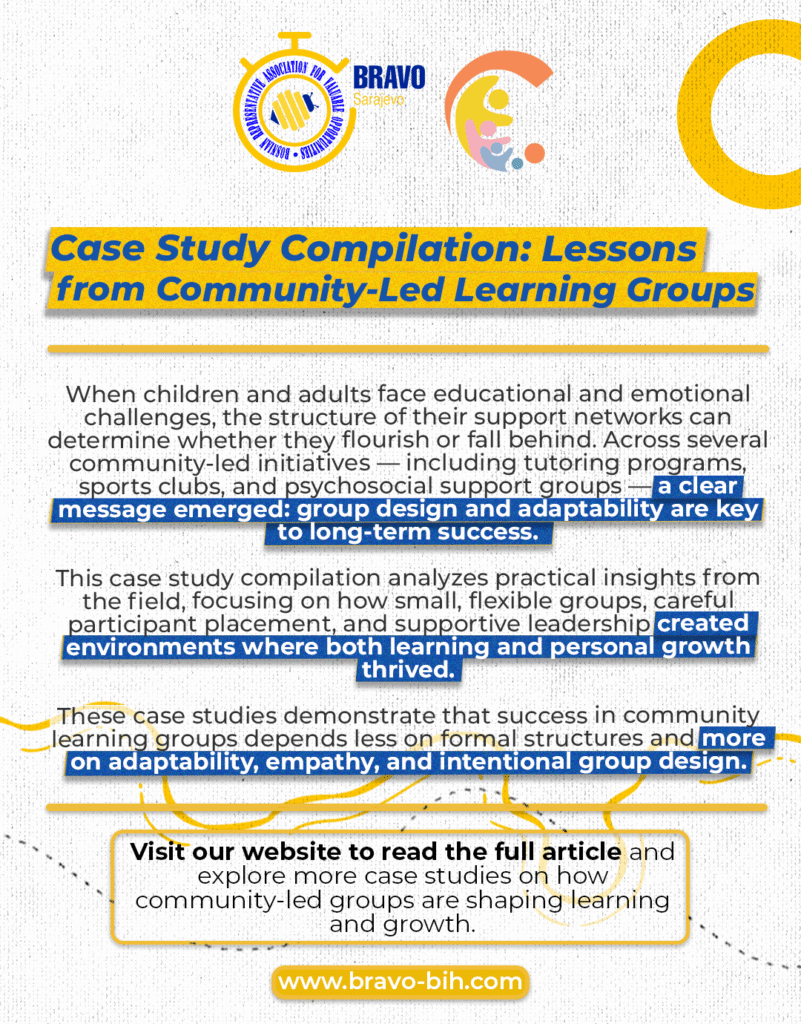
Introduction
When children and adults face educational and emotional challenges, the structure of their support networks can determine whether they flourish or fall behind. Across several community-led initiatives — including tutoring programs, sports clubs, and psychosocial support groups — a clear message emerged: group design and adaptability are key to long-term success.
This case study compilation analyzes practical insights from the field, focusing on how small, flexible groups, careful participant placement, and supportive leadership created environments where both learning and personal growth thrived.
Key Findings
- Group Size and Flexibility Matter
Rigid, classroom-style setups often hindered progress. Small, carefully formed groups allowed participants to feel seen and supported. Leaders adjusted group composition over time, showing that flexibility was as important as initial design. - Informed Placement Prevents Conflict
Background assessments — through observation, conversations, or caregiver input — helped leaders understand participants’ needs before placing them into groups. This reduced the risk of mismatches, supported emotional safety, and promoted trust.
- Emotional Support Beyond Academics
Many participants lacked consistent parental involvement. In response, volunteers, coaches, and mentors assumed roles that went far beyond teaching. They became confidants, role models, and emotional anchors. While effective, this highlighted the urgent need for stronger professional support systems. - Partnerships Strengthen Outcomes
Programs with links to schools, universities, or health professionals had access to expertise that improved their work. Those operating in isolation often struggled when faced with complex behavioral or emotional challenges. - Rethinking Success Metrics
Academic progress was only one part of the picture. Programs that tracked social and emotional development — cooperation, confidence, participation, and resilience — saw the most meaningful impact.
Case Examples
- Tutoring Programs created tailored groups based on learning style and readiness. When difficulties arose, facilitators provided one-on-one sessions or adjusted group structures, preventing exclusion.
- Sports Initiatives used preparatory sessions and informal interviews to understand participants’ personalities. This groundwork built trust, reduced conflict, and turned physical activity into a tool for inclusion.
- Psychosocial Groups prioritized emotional safety, sometimes delaying group entry until participants were ready. This gradual approach protected vulnerable individuals from stress and ensured that inclusion was supportive, not forced.
Recommendations for Practice
- Begin with Background Assessments – Gather information before forming groups to ensure emotional and social compatibility.
- Prioritize Flexibility – Allow for ongoing adjustments in group size and dynamics.
- Build Support Systems – Provide volunteers with mentorship, professional connections, and training in trauma-informed approaches.
- Recognize Alternative Role Models – Encourage mentors, coaches, and siblings to take on supportive roles when parents are absent.
- Measure Growth Holistically – Track emotional and social development alongside academic results.
Conclusion
These case studies demonstrate that success in community learning groups depends less on formal structures and more on adaptability, empathy, and intentional group design. By combining careful preparation with flexibility, leaders created spaces where participants not only learned but also built trust, resilience, and a sense of belonging.
The lessons are clear: even modest community initiatives can transform lives when they focus on people first, structure second.
MORE ABOUT THE PROJECT
The CPC project is designed to empower parents to start and manage learning groups effectively, providing an alternative or supplement to traditional public education. It’s particularly relevant in crisis situations where conventional educational structures may falter. The project envisions learning groups as small, organized communities that deliver regular educational content outside the public system. Examples include small private school communities in Hungary that follow the national curriculum but employ alternative teaching methods. Similar home-schooling communities exist in Portugal and Germany.
The project’s operations span several phases, beginning with preparations like kick-off events and local knowledge transfer seminars. The initial stages focus on data collection through research on existing student groups across various countries. Each partner country is tasked with examining specific aspects of these groups to create a collection of best practices.
These practices will then be synthesized into a comprehensive Learning Group Management (LGM) methodology. The final output will be a training manual alongside facilitator training sessions. The methodology will cover six key themes ranging from building a learning community to integrating digital tools and supporting children with special needs.
The project also involves creating a robust digital presence, including a project website and social media engagement to foster a wider community interaction and dissemination of project results. Fieldwork will follow, with local and international training sessions for facilitators who will then train parents directly. The aim is to make these learning groups viable and sustainable options for parents looking to supplement their children’s education or provide a solid alternative during disruptive times.
Ultimately, the project not only addresses the educational needs of children but also equips parents with the necessary tools and knowledge to lead these initiatives effectively. The focus on a supportive learning environment, blended learning methods, and inclusive education practices underscores the project’s commitment to a holistic educational approach. This initiative is aligned with the EU’s educational objectives and offers a practical response to the growing need for adaptable educational formats in light of global challenges like climate change and societal disruptions.
